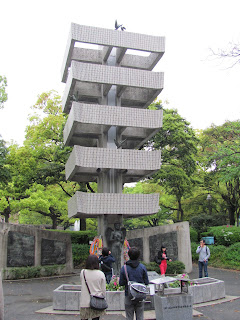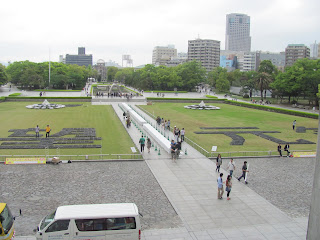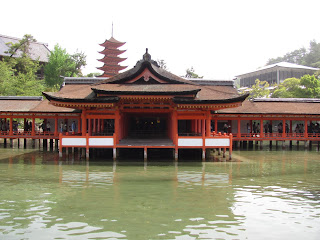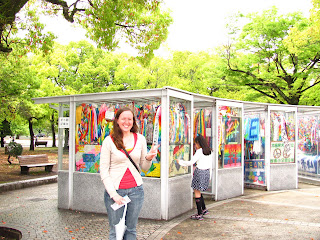Golden Week for Peace
WARNING: This is going to be a long entry.
Let's just talk about how awesome Golden Week is.
I've heard a few different explanations for its origins (like most things I've experienced in Japan), so I'll recount a bit. April 29 and May 3-5 are all national holidays, which means that this awesome concentration of holidays allows for the perfect week-long, government-mandated vacation. It also falls at the end of the first month of the fiscal year, and as you may remember from a previous post, March and April are crazy busy for Japanese people, so Golden Week is a well-deserved break for all the hard work everyone has done in the past few months. It ususally turns into a week-long chance to travel, sightsee, and relax with family and friends. It really is just the chance to kick back a little while the weather is still nice and when there is a lull in the work that needs to get done.
So what did I do? TRAVEL.
I booked my shinkansen tickets (the bullet train!) to Hiroshima for April 30-May 4, reserved a hostel, researched the area, packed my backpack, and took off for Hiroshima. It was one of the places I wanted to visit most while in Japan, but to be honest, I've always had an interest in visiting this historic city. Sarah and Peter were both busy with other things during the week, so I took off on a solo adventure south.
First, the shinkansen: It's. So. Fast. Seriously. I left from Nagoya, and a trip to Kyoto that normally takes 2 hours by regular train took 20 minutes. Kyoto to Osaka? 5 minutes. Seriously. It took me 2 hours to get down to Hiroshima, which is kind of mind-boggling. The tickets are definitely spendy, but the experience of riding these famously fast trains was definitely worth it.
On my first day in Hiroshima, I wasn't able to check into my hostel until 3pm, and I arrived at 11:30am, so I did some sightseeing right away. I'm glad I did, because I got a feel for the city immediately, but traipsing through a big Japanese city with a huge packpack and heavy purse was less than stellar. I had forgotten that wonderful joy of traveling (something I haven't done since Europe). Thanks to some helpful tips from one of the previous teachers, I was able to purchase a tram pass right away and take advantage of the street car system. However, I think I bumped just about everyone on the tram with my backpack and I'm sure garnered more than a few "Oh, Americans..." eyerolls. Whoops. Americans take up more space!
 |
| Tram car |
My first stop was Shukkei-en garden, which is of course a recreation of the traditional Japanese garden that was there before the 1945 bombing. It was absolutely stunning - one of the prettiest gardens I've visited in Japan.
 |
| A little city oasis |
After that, I walked to Hiroshima castle, which is again a replica of the castle that stood in Hiroshima when it was first established as a castle town hundreds of years ago. It, too, went down with the bomb. It was during my walk through the castle grounds that I saw my first piece of A-bomb history: a tree that had withstood the blast. It was a big, solid tree, but it was being held up with metal stakes and had a huge rope looped around its trunk. You could see that its branches were growing strangely, like it had been hurt in some way. There was a little plaque marking that it was a special tree, and when I read that, the magnitude of what the trip would be hit me. It's hard to make this not sound melodramatic - I mean, it's a tree - but it was really powerful to see something that survived in a place where virtually nothing else did. The entire city has been built since 1945, and the entire history of the city and its people that existed before that time is gone. It's hard to stomache, and when you think about the vast scale of the human devastation that the bomb caused, and then find yourself staring at something so innocent - a tree - the perspective is jarring, and teary eyes are inevitable.
 |
| The tree |
After the castle, I took off for my hostel, which was fantastic. It was by far the nicest hostel I've ever stayed in - clean, safe, and affordable. I opted for a Japanese-style room, but I will not be converting to sleeping on futon on the floor any time soon. Still, it was a good experience to have, and it was great to know that I always had a safe place to return to each night. (And a 5-minute walk from Mazda Stadium, home of the Hiroshima Carp!)
I capped off my night with a trip to the Catholic church in Hiroshima, which was officially dedicated as the Hiroshima Memorial Cathedral for World Peace and was the site of JPII's 1981 Appeal for Peace. I got a tour from a nice man working there and enjoyed mass.
Sunday was my Peace Memorial Park day. I got up early and headed to the park. The tram stop is literally right next to one of the most iconic places in the world: the A-bomb, or Genbaku, Dome. It was once the Hiroshima Prefectural Industrial Promotion Hall, but since August 6, 1945, it has been a stark reminder of WWII and a symbol for world peace. Walking around the dome was eerie and humbling, but a strange as it sounds, it was also a really cool experience. Peace Park is one of the most respectful, honest, and beautiful memorials I've ever seen, and the whole place is almost perfectly executed. It's a memorial to those whose lives were lost, without demanding pity or guilt. Unnecessary blame is not placed on anyone, the facts are straightforward, and more than anything, it has become an area devoted to achieving world peace (in the least cliche way possible). To be a part of that in some small way was really, really awesome.
 |
| Memorial for the Mobilized Children Japanese children were forced to help in the war effort, and many of them died in the bombing. |
I walked around the whole park and then entered the Hiroshima Peace Memorial Museum. It's only 50 yen to enter (about 75 cents), and this is the museum about Hiroshima, WWII, the A-bomb, and world peace. This was one of the top destinations for me on this trip, so I took my time getting through there. I walked around for a good two and a half hours, reading the information, seeing the artifacts that survived the blast, and listening to the stories of the survivors (sprung for the audio tour). Not to sound redundant, but the museum was so well-done. For those of you who know a lot about WWII (which I don't claim to), Japan wasn't exactly a shining example of awesome humanitarianism. But the museum, like the entire city, makes no effort to cover that up. But it also doesn't dwell on it. Again, it's all about the facts, the devastation caused, and the reminder that nuclear war really is a terrible option. One of the most moving parts of the museum for me was seeing copies of the protest letters that the mayor of Hiroshima sends to the leaders of different countries when they authorize the detonation of a nuclear weapon (for training, research, etc.). It's hard not to get wrapped up in the peace effort while in Hiroshima.
 |
| Peace Park |
 |
| Hiroshima Memorial Cenotaph, where the names of the A-bomb victims are memorialized. Notice that when you look directly through the cenotaph, you can see the dome. |
 |
| Peace Flame, which has been lit since 1964 and will remain lit until the last nuclear weapon on Earth is destroyed. |
One of the coolest parts of the whole experience was seeing the Children's Peace Monument, inspired by Sadako and the Thousand Paper Cranes. Who didn't read that story as a child in elementary school and think that they, too, could fold a thousand paper cranes and make a wish come true? Well, I saw the monument and the cranes, both the ones she really folded and the thousands that have been sent to Hiroshima from around the world. Again: such a surreal experience.
After a great day in Peace Park, I headed to a mom-and-pop type okonomiyaki shop for the famous Hiroshima okonomiyaki (special because it includes soba noodles). They were happy to have me there, and I even made a few friends!
The next day, I headed to Miyajima. It's an island off the coast of Hiroshima. It takes about 10 minutes to reach it by ferry, and it is one of the most iconic places in all of Japan. You might recognize the floating Torii gate, which is actually part of Itsukushima Shrine. The whole island is considered sacred, but it's also now a huge tourist place with an unreal number of shops. It's like Nara and Ise combined in terms of tourism, but it was still fun. I went early so I could see the gate at high tide, but it surprised me that it was actually way cooler to experience it at low tide. When the tide is out, you can walk out and stand under it, touch it, and leave a coin and make a wish. It was an awesome reminder of just how lucky I am to have this experience. We've all seen that gate, and now I've stood under it! It's unbelievable!
 |
| The entire shrine "floats." |
Miyajima is full of cool little temples, and it's also home to Mt. Misen, a very sacred mountain. I did take the ropeway up to the top, and from there it's only a 1 km hike to the summit, but after about 3 minutes of intense uphill hiking, I quit. I just have to admit to myself that I'm not a hiker, and I never will be. And you know what? That's okay with me! I had a great time touring the temples and doing a little shopping instead!
 |
| The Ropeway...not my thing |
 |
| Five-story pagoda Pagodas are my favorite things in Japan. |
 |
| Daisho-In Temple 500 Raken Statues |
 |
| Daisho-In Temple 1000 Fudo Images |
 |
| Spinning the Mani Wheel is, according to the Daisho-In brochure, believed to invite blessings equivalent to reading one volume of the Heart Sutra. |
Tuesday was the first day of the famous Hiroshima Flower Festival. I went back down to Peace Park for the parade and festivities, which was cool for a while, but after about 20 minutes of the parade (like the Rose Bowl or something....so big!) and the crowd, I left for a quiet bistro and lunch. There were just too many people, and by that point, I had already done a lot of touring on my vacation. I wanted a little relaxation time!
 |
| Tons of cranes for the Flower Festival |
The rest of my vacation was spent reading in coffee shops, walking around the shopping areas, and having a pint or two at the authentic Irish pub I stumbled upon. It was a fantastic vacation, and I don't think I'd do any of it differently. I'm so glad and grateful that I was able to experience that part of Japan, and I know it has given me an even better understanding of the Japanese history and people. If you ever get the chance to go to Hiroshima, take it.
Take care, dear friends, and please: pray for peace. Read more...

































